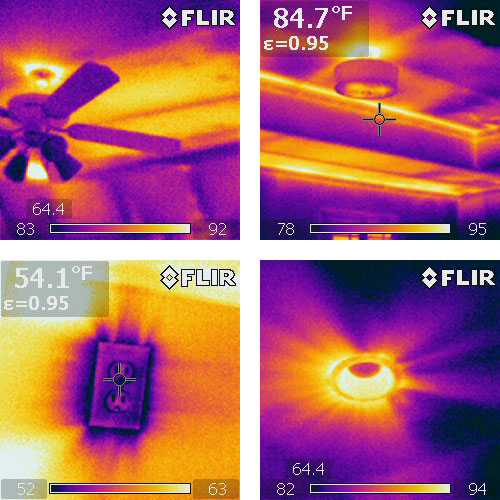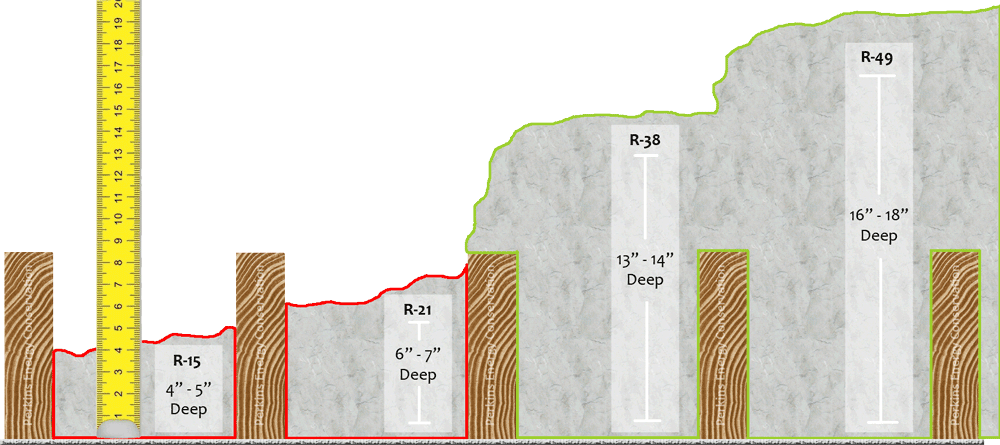Blower Door Air Leak Test
A blower door is an innovative diagnostic tool used in energy audits to measure a building's airtightness. By simulating pressure differences, it helps detect and quantify air leaks, enabling precise identification and sealing of areas that compromise energy efficiency and indoor comfort.
Infrared Testing
When combined with a blower door, an infrared scan is a powerful duo in energy auditing. The blower door pressurizes or depressurizes the building to reveal air leaks, while the infrared scan visually highlights temperature differences, making it easy to pinpoint energy-wasting gaps in the building envelope.
Additional Pressure Pan Testing
During a blower door test, a pressure pan is positioned over supply and return vents to measure air pressure differentials, enabling the evaluation of heat or cooling loss and the identification of potential airflow issues or leaks within specific duct runs. *There is an additional cost to perform this test during a blower door.
Blower Door Testing
Blower door testing stands at the forefront of comprehensive energy audits, offering an indispensable means to evaluate a building's air tightness and energy efficiency. This advanced diagnostic technique involves the use of a specialized fan and pressure measurement devices to detect air leaks within a structure. By manipulating air pressure, the blower door helps reveal areas where drafts or uncontrolled airflows occur, enabling precise identification of potential energy inefficiencies. Through this process, experts can accurately pinpoint locations that require sealing or insulation improvements, ultimately leading to enhanced energy conservation, increased comfort, and cost savings for homeowners or building managers. Blower door testing not only serves as a foundational step in energy audits but also plays a vital role in creating more sustainable and energy-efficient buildings. Rest assured, when you choose Perkins Inc., you are selecting a partner that prioritizes the science of home performance evaluation to ensure your energy conservation and comfort needs are met with precision and expertise.
Blower Door Testing
$250
- Blower Door Pressure Test
- Infrared Scan
- Pictures Of Problem Areas
- Gas Leak Test If Applicable
- Report Of Air Tightness Testing
- Report Of Air Tightness Testing
- $50 Additioanl For Pressure Pan Test
- Duct Leak Testing Not Included
- Repairs Not Made
How A Blower Door Works

The Blower Door
The blower door, a sizable fan installed into an exterior doorway, works by either pressurizing or depressurizing air within a building, creating a vacuum effect that uncovers points of air infiltration or escape. Connected sensors measure a structure's airtightness by assessing pressure differences between the homes interior and exterior. This method identifies air leakage sites, illuminating areas needing insulation or air sealing enhancements to boost a building's energy efficiency and overall comfort. Paired with an infrared camera, this combination forms a powerful tool for assessing a building's air tightness and insulation. While the blower door depressurizes the building to reveal air leakage zones, the infrared camera, sensitive to temperature variations, captures images displaying the thermal contrasts associated with these leaks. This combined method offers a thorough evaluation of a building's energy performance, uncovering both the overall air leakage and specific areas requiring insulation or sealing improvements. This integrated technology aids in identifying and remedying energy inefficiencies, providing a comprehensive understanding of a building's energy loss.
Why You Need A Blower Door:
- Identifies Air Leaks: Pinpoints areas where air may infiltrate or escape from a building, helping to seal off these leaks.
- Determines Airtightness: Measures the overall airtightness of a structure by evaluating pressure differences between the inside and outside.
- Enhances Energy Efficiency: Assists in improving a building's energy efficiency by identifying areas that need insulation or sealing enhancements.
- Improves Comfort: Helps create a more comfortable living or working environment by maintaining a consistent indoor temperature and reducing drafts.
- Reduces Energy Costs: Minimizes energy consumption by identifying and rectifying air leaks, thereby lowering heating and cooling costs.
- Validates Building Codes: Assists in meeting energy efficiency standards and codes required for construction or renovation.
- Combined Assessment: When paired with infrared cameras, provides a comprehensive evaluation of a building's energy performance by visualizing temperature variations and identifying specific areas for improvements.




Blower Door: Just part of the puzzle
Blower Door Testing
$250
- Blower Door Pressure Test
- Infrared Scan
- Pictures Of Problem Areas
- Gas Leak Test If Applicable
- Report Of Air Tightness Testing
- Report Of Air Tightness Testing
- $50 Additioanl For Pressure Pan Test
- Duct Leak Testing Not Included
- Repairs Not Made
Complete Home Performance Test
$400
- Blower Door Pressure Test
- Duct Blaster Test
- Infrared Test
- Gas Leak Test If Applicable
- Pictures Of Problem Areas
- Report Of Air Tightness Testing
- Recommended Upgrades
- Repairs Not Made
Duct Leak Testing
$250 / per unit
- Duct Blaster Pressure Test
- Duct Leak Inspection
- Duct Condition Inspection
- Report Of Duct Pressure Test
- Pictures Of Problem Areas
- Infrared Test
- Blower Door Testing
- Repairs Not Made
Is Your Attic Costing You Money?!?!
All it takes is a quick peek to find out! Many older homes have more air leaks and less insulation than homes built today. If your attic floor is insulated but the wood beams (joists) are still visible, you probably don’t have enough attic insulation and it wouldn’t be a bad idea to reach out to us today for a free insulation quote!


